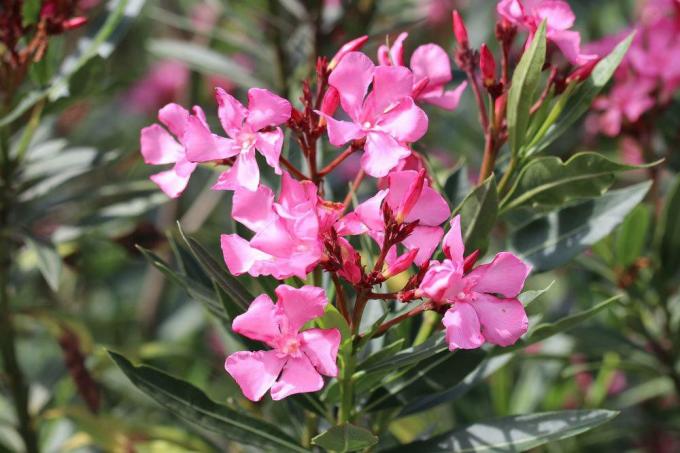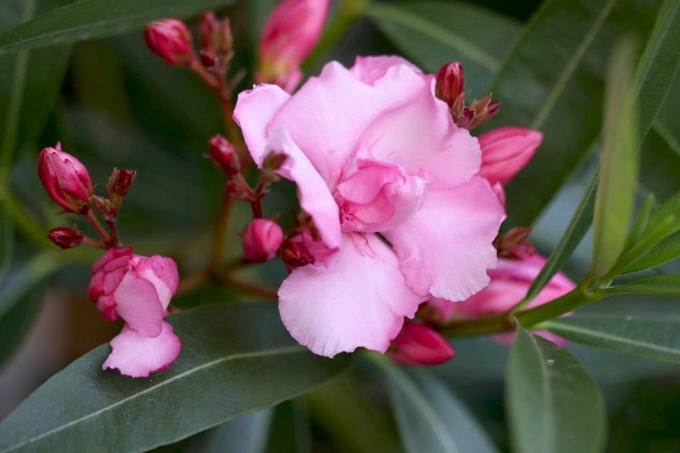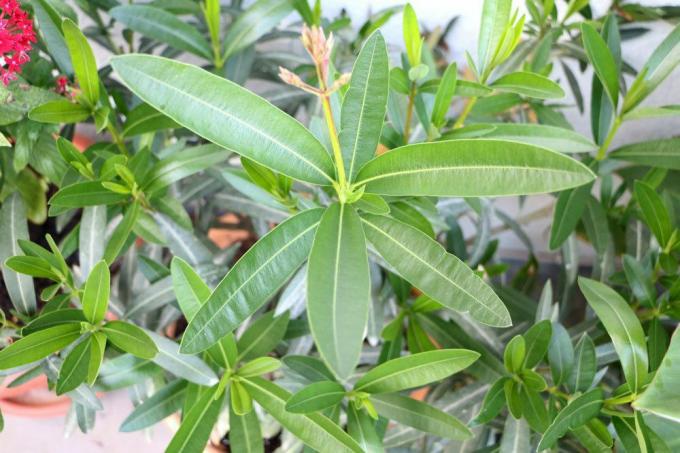
table of contents
- Poison in the oleander
- Effect of the poison
- Symptoms of poisoning
- person
- animal
- Precautions
- Oleander as a medicinal plant
When looking at the beautiful flowers of the oleander, many people quickly fall into raptures. The lush flowering shrubs remind us of sun, beach and sea. That's why the oleander, also called rose laurel, we like to cultivate it as a container plant. What pleases the heart can be fatal to the heart, because the shrub is poisonous in all parts. Its poison can even lead to cardiac arrest at the appropriate dose. Therefore one should always treat him with due respect.
Poison in the oleander
The oleander, lat. Nerium oleander, is the only plant in the genus Nerium and belongs to the dog venom family. We cultivate the plant in a tub and, as the name of the plant family suggests, it is very poisonous. The concentration of poison in the leaves is particularly high. The poison contained in rose laurel is the cardiac glycoside oleandrin.
Effect of the poison
Oleandrin begins to work when parts of the shrub are chewed and swallowed. The poisonous cardiac glycoside stimulates the intercardiac muscle activity. In addition, ingestion of the poison causes hypoxemia. Human and animal deaths result from cardiac paralysis.
Touching the plant alone does not result in fatal poisoning, but can cause severe skin irritation. However, caution is advised when cutting the oleander. If the sap of the plant penetrates the body through wounds on the skin, this can lead to poisoning. It can also cause allergic reactions such as itching and redness on healthy skin.

Therefore, gardening gloves should always be worn when working with the plant and the cutting waste should be disposed of safely. Also, don't forget to clean the secateurs after you've cut them. A quasi-natural protection against oleander poisoning is its extremely bitter taste. This leads to the consumed parts of the plant being spit out or vomited immediately.
Symptoms of poisoning
The oleander bush is poisonous to humans and animals. The severity of the poisoning depends on the dose administered. As a rule of thumb, the lower your height and weight, the lower the lethal dose. The first symptoms of poisoning can appear in humans after consuming a few leaves. The lethal dose is given as 15 to 20 grams of oleander leaves.
Since the glycoside in rose laurel causes cardiac arrhythmias with a corresponding amount, which in the case of severe poisoning already after two up to three hours can lead to death, if you suspect oleander poisoning you should call the appropriate emergency numbers for humans respectively. Call animal immediately.

person
Symptoms of poisoning in humans
- Vomit
- diarrhea
- headache
- cramps
- Slowed pulse
- Dilation of the pupil
- blue lips and hands
If symptoms of intoxication appear, drinking water or juice is an effective first aid measure. If possible, see a doctor straight away or drive straight to the hospital. Under no circumstances should you induce vomiting or milk to drink in the poisoned person. He can choke on the former, and milk promotes the absorption of the poison through the intestines.
animal
Symptoms of poisoning in animals
Rose laurel is deadly poisonous to pets such as dogs and cats, rabbits, and guinea pigs and hamsters. However, oleandrin also leads to death from cardiac paralysis in horses, cattle, goats and sheep in the appropriate amount. The lethal dose for dogs and cats is less than a gram of oleander leaves. The life of your darling is extremely dangerous when cramps and vomiting occur.
- Dilation of the pupil
- Decrease in body temperature
- cool legs
- Stomach and intestinal discomfort
- diarrhea
- cramps
- Vomit
Flowers or leaves lying on the ground represent a particular danger for puppies. The young dogs can swallow the plant parts out of curiosity. Since the shrub is often set up as an ornamental plant in parks or other public places, you should definitely keep your dog on a short leash in these places.

For cats, sharpening the claws on the oleander trunk can be fatal. In this case, the poison enters the body with the sap of the plant. If your pet shows signs of poisoning, a veterinarian should be consulted immediately. Infusions and appropriate medication should help the animal to excrete the poison. As with humans, do not make the animal vomit. Instead, offer them water to drink.
Precautions
Various precautionary measures should be taken to protect children and pets from poisoning.
- Doing without the plant is the best protection
- Place out of the reach of children and pets
- Immediately dispose of fallen flowers, leaves or small branches safely
- Dispose of clippings in a child and pet-safe manner
- The winter quarters must also be safe
- increased caution in playgrounds and in hotel complexes
When working with the plant, you should always wear gardening gloves, long trousers and long-sleeved outerwear to avoid any skin contact. Depending on the size of the oleander, protective goggles are also recommended.
Under no circumstances should the branches of the oleander be used as grill skewers, as the poison can be used when grilling or grilling. The skewer penetrates the food.

Oleander as a medicinal plant
Like many poisonous plants, rose laurel is also used in medicine. In classical medicine it is used as a heart medicine. In homeopathy it is used for weakness and damage to the heart muscle, for edema, angina pectoris and for stomach and intestinal inflammations.
Since the plant is highly poisonous, you should definitely not experiment with the oleander. A homeopathic application may only be carried out under medical supervision.


